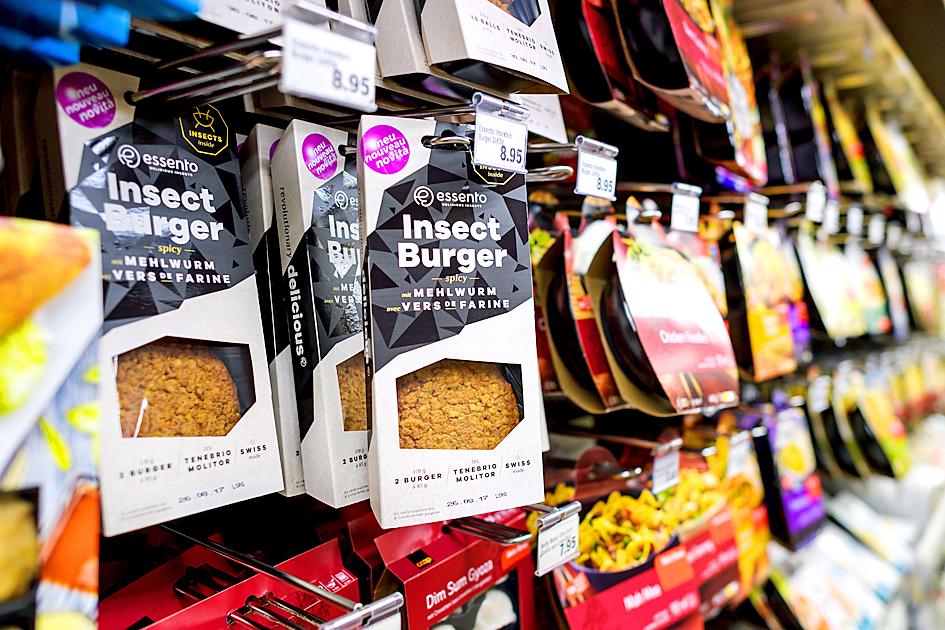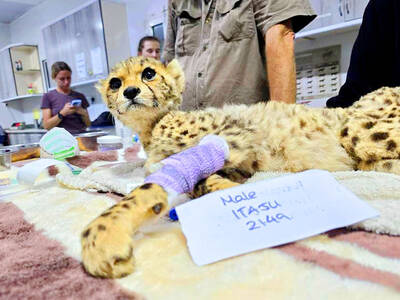Insects just moved a step closer to European dinner plates.
Dried yellow mealworm, the larval form of the mealworm beetle, is safe for human consumption in both its whole form and as a powder additive, the EU’s food watchdog said on Wednesday, ruling on an application by French insect farmer EAP Group SAS - Micronutris, now known as Agronutris.
The European Food Safety Authority’s (EFSA) opinion is a first step before officials consider whether to approve sales of snacks, protein bars, cookies and other foods containing the bugs as ingredients.

Photo: AFP
The decision is a jolt for the insect-farming business, which researcher Arcluster predicts could grow 10-fold to exceed US$4.1 billion globally by 2025.
Insects are emerging as a more sustainable source of protein thanks to their lower environmental impact and high nutritional value, attracting record venture-capital financing and attention from giants such as Cargill and Nestle SA.
“It’s a clear and important milestone for the whole sector,” said Antoine Hubert, cofounder of France’s Ynsect SAS, which rears mealworms and plans to expand into sports nutrition. “There will be a snowball effect. It will increase the potential to invest in further capacity and attract further funding to support the growth.”
This is the first risk assessment of insects as novel food by the Parma, Italy-based EFSA, which has another 14 pending applications for bugs — from crickets to grasshoppers.
It also said allergic reactions to the mealworms are possible, so more research needs to be done.
Europe is at the forefront of the burgeoning insect-start-up scene, identifying bugs as part of its sustainable food agenda.
EU authorities have poured money into research and factories, and the bloc already allows fish, dogs and cats to eat insect meal.
Feeding animals, rather than humans, has shown the biggest promise. The International Platform of Insects for Food and Feed expects poultry and pigs to come next.
Of Europe’s projected output of 3 million tonnes of insect protein in 2030, only 10 percent would go into human food, with much of the rest going into animal feed, the Brussels-based lobby group estimated.
“There are more and more opportunities to work with new sustainable ingredients for the animal feed industry,” Helene Ziv, risk management and sourcing director for Cargill’s animal-nutrition business, said in an interview. “Insects is actually one which we strongly believe in. We’re very comfortable about its nutritional quality.”
Cargill has a partnership with InnovaFeed SAS to supply insect protein for fish feed, while Archer-Daniels-Midland Co is planning a giant black soldier fly farm in Illinois.
Nestle, the world’s biggest food company, added a pet food range made with insects.
A handful of EU states — including Finland, Belgium and the Netherlands — already permit sales of bug-containing foods in shops.
About 2,000 insect species are in the diets of about 2 billion people worldwide, but many consumers in Europe have to overcome what Niccolo Manzoni, managing partner at Paris-based Five Seasons Ventures, calls the “ick factor.”
That is not the only hurdle.
Insect-feed makers require substantial funds to scale up production in order to be cost-competitive, Manzoni said.
The industry has a long way to go to reach the commercial volumes supplied now by the marine ingredients sector, said Anne Mette Baek, director of the Copenhagen–based European Fish Meal and Fish Oil Producers.
One company already moving toward the dinner table is Protix BV, which operates Europe’s biggest insect farm and has investors including Aqua-Spark and Rabobank’s private equity arm.
The Dongen, Netherlands-based manufacturer rears black soldier fly larvae for feeding to fish and pets, and last summer it opened an online store selling foods made with crickets and mealworms.

END OF AN ERA: The vote brings the curtain down on 20 years of socialist rule, which began in 2005 when Evo Morales, an indigenous coca farmer, was elected president A center-right senator and a right-wing former president are to advance to a run-off for Bolivia’s presidency after the first round of elections on Sunday, marking the end of two decades of leftist rule, preliminary official results showed. Bolivian Senator Rodrigo Paz was the surprise front-runner, with 32.15 percent of the vote cast in an election dominated by a deep economic crisis, results published by the electoral commission showed. He was followed by former Bolivian president Jorge “Tuto” Quiroga in second with 26.87 percent, according to results based on 92 percent of votes cast. Millionaire businessman Samuel Doria Medina, who had been tipped

ELECTION DISTRACTION? When attention shifted away from the fight against the militants to politics, losses and setbacks in the battlefield increased, an analyst said Recent clashes in Somalia’s semi-autonomous Jubaland region are alarming experts, exposing cracks in the country’s federal system and creating an opening for militant group al-Shabaab to gain ground. Following years of conflict, Somalia is a loose federation of five semi-autonomous member states — Puntland, Jubaland, Galmudug, Hirshabelle and South West — that maintain often fractious relations with the central government in the capital, Mogadishu. However, ahead of elections next year, Somalia has sought to assert control over its member states, which security analysts said has created gaps for al-Shabaab infiltration. Last week, two Somalian soldiers were killed in clashes between pro-government forces and

Ten cheetah cubs held in captivity since birth and destined for international wildlife trade markets have been rescued in Somaliland, a breakaway region of Somalia. They were all in stable condition despite all of them having been undernourished and limping due to being tied in captivity for months, said Laurie Marker, founder of the Cheetah Conservation Fund, which is caring for the cubs. One eight-month-old cub was unable to walk after been tied up for six months, while a five-month-old was “very malnourished [a bag of bones], with sores all over her body and full of botfly maggots which are under the

BRUSHED OFF: An ambassador to Australia previously said that Beijing does not see a reason to apologize for its naval exercises and military maneuvers in international areas China set off alarm bells in New Zealand when it dispatched powerful warships on unprecedented missions in the South Pacific without explanation, military documents showed. Beijing has spent years expanding its reach in the southern Pacific Ocean, courting island nations with new hospitals, freshly paved roads and generous offers of climate aid. However, these diplomatic efforts have increasingly been accompanied by more overt displays of military power. Three Chinese warships sailed the Tasman Sea between Australia and New Zealand in February, the first time such a task group had been sighted in those waters. “We have never seen vessels with this capability